
Peroz I was the Sasanian King of Kings of Iran from 459 to 484. A son of Yazdegerd II, he disputed the rule of his elder brother and incumbent king Hormizd III, eventually seizing the throne after a two-year struggle. His reign was marked by war and famine. Early in his reign, he successfully quelled a rebellion in Caucasian Albania in the west, and put an end to the Kidarites in the east, briefly expanding Sasanian rule into Tokharistan, where he issued gold coins with his likeness at Balkh. Simultaneously, Iran was suffering from a seven-year famine. He soon clashed with the former subjects of the Kidarites, the Hephthalites, who possibly had previously helped him to gain his throne. He was defeated and captured twice by the Hephthalites and lost his recently acquired possessions.

Bahram II was the fifth Sasanian King of Kings (shahanshah) of Iran, from 274 to 293. He was the son and successor of Bahram I. Bahram II, while still in his teens, ascended the throne with the aid of the powerful Zoroastrian priest Kartir, just like his father had done.

Bahram IV, was the Sasanian King of Kings of Iran from 388 to 399. He was likely the son and successor of Shapur III.

Shapur II, also known as Shapur the Great, was the tenth Sasanian King of Kings (Shahanshah) of Iran. The longest-reigning monarch in Iranian history, he reigned for the entirety of his 70-year life, from 309 to 379. He was the son of Hormizd II.

Vāsudeva I was a Kushan emperor, last of the "Great Kushans." Named inscriptions dating from year 64 to 98 of Kanishka's era suggest his reign extended from at least 191 to 232 CE. He ruled in Northern India and Central Asia, where he minted coins in the city of Balkh (Bactria). He probably had to deal with the rise of the Sasanians and the first incursions of the Kushano-Sasanians in the northwest of his territory.
The Kidarites, or Kidara Huns, were a dynasty that ruled Bactria and adjoining parts of Central Asia and South Asia in the 4th and 5th centuries. The Kidarites belonged to a complex of peoples known collectively in India as the Huna, and in Europe as the Chionites, and may even be considered as identical to the Chionites. The 5th century Byzantine historian Priscus called them Kidarite Huns, or "Huns who are Kidarites". The Huna/Xionite tribes are often linked, albeit controversially, to the Huns who invaded Eastern Europe during a similar period. They are entirely different from the Hephthalites, who replaced them about a century later.
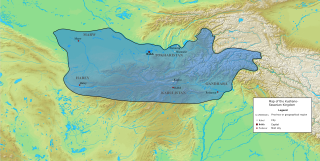
Kushano-Sasanian Kingdom is a historiographic term used by modern scholars to refer to a branch of the Sasanian Persians who established their rule in Bactria during the 3rd and 4th centuries CE at the expense of the declining Kushans. They captured the provinces of Sogdiana, Bactria and Gandhara from the Kushans in 225 CE. The Sasanians established governors for the Sasanian Empire, who minted their own coinage and took the title of Kushanshas, i.e. "Kings of the Kushans". They are sometimes considered as forming a "sub-kingdom" inside the Sasanian Empire. This administration continued until 360-370 CE, when the Kushano-Sasanians lost much of its domains to the invading Kidarite Huns, whilst the rest was incorporated into the imperial Sasanian Empire. Later, the Kidarites were in turn displaced by the Hephthalites. The Sasanians were able to re-establish some authority after they destroyed the Hephthalites with the help of the Turks in 565, but their rule collapsed under Arab attacks in the mid 7th century.

The Pāratarājas or Pāradarājas was a dynasty of Parthian kings in the territory of modern-day western Pakistan from circa 125 CE to circa 300 CE. It appears to have been a tribal polity of Western Iranic heritage.

Kipunada, also Kipanadha, was probably the last ruler of the Kushan Empire around 335-350 CE. He is known for his gold coinage. He succeeded Shaka I. Kipunada was probably only a local ruler in the area of Taxila, in western Punjab, and he may have been a subject of Gupta Emperor Samudragupta.
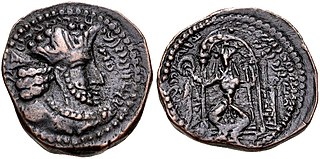
Kushanshah was the title of the rulers of the Kushano-Sasanian Kingdom, the parts of the former Kushan Empire in the areas of Sogdiana, Bactria and Gandhara, named Kushanshahr and held by the Sasanian Empire, during the 3rd and 4th centuries CE. They are collectively known as Kushano-Sasanians, or Indo-Sasanians.
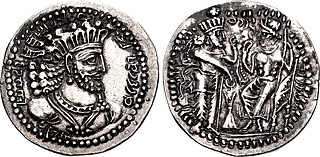
Peroz I Kushanshah was Kushanshah of the Kushano-Sasanian Kingdom from 245 to 275. He was the successor of Ardashir I Kushanshah. He was an energetic ruler, who minted coins in Balkh, Herat, and Gandhara. Under him, the Kushano-Sasanians further expanded their domains into the west, pushing the weakened Kushan Empire to Mathura in North India.
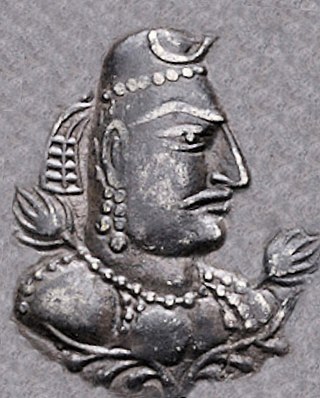
The Alchon Huns, also known as the Alchono, Alxon, Alkhon, Alkhan, Alakhana, and Walxon, were a nomadic people who established states in Central Asia and South Asia during the 4th and 6th centuries CE. They were first mentioned as being located in Paropamisus, and later expanded south-east, into the Punjab and Central India, as far as Eran and Kausambi. The Alchon invasion of the Indian subcontinent eradicated the Kidarite Huns who had preceded them by about a century, and contributed to the fall of the Gupta Empire, in a sense bringing an end to Classical India.

Hormizd I Kushanshah was Kushanshah of the Kushano-Sasanian Kingdom from 275 to 300. His reign was marked by his rebellion against his brother and suzerain the Sasanian King of Kings Bahram II.

BahramKushanshah, was the last Kushanshah of the Kushano-Sasanian Kingdom from 330 to 365. He was the successor of Peroz II Kushanshah.

Peroz II Kushanshah was the penultimate Kushanshah of the Kushano-Sasanian Kingdom from 303 to 330. He was the successor of Hormizd II Kushanshah.

Peroz, was according to modern scholarship an early Kidarite ruler in Gandhara, right after the end of Kushano-Sasanians.
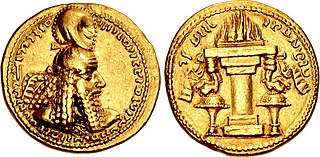
Sasanian coinage was produced within the domains of the Iranian Sasanian Empire (224–651). Together with the Roman Empire, the Sasanian Empire was the most important money-issuing polity in Late Antiquity. Sasanian coinage had a significant influence on coinage of other polities. Sasanian coins are a pivotal primary source for the study of the Sasanian period, and of major importance in history and art history in general. The Sylloge nummorum Sasanidarum is the most important primary work of reference for Sasanian coins.

The Sasanian coinage of Sindh refers to a series of Sasanian-style issues, minted from 325 to 480 CE in Sindh and Kutch, in modern-day Pakistan and India, respectively, with the coin type of successive Sasanian Empire rulers, from Shapur II to Peroz I. Together with the coinage of the Kushano-Sasanians, these coins are often described as "Indo-Sasanian". They form an important part of Sasanian coinage.
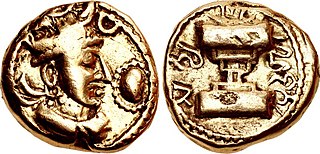
Rāṇāditya Satya, was a ruler in the area of Sindh, modern-day Pakistan, in the 5-6th centuries CE, probably circa 480 CE. The name "Rāṇāditya" is otherwise known, and it appears in several parts of the Rajatarangini.





























